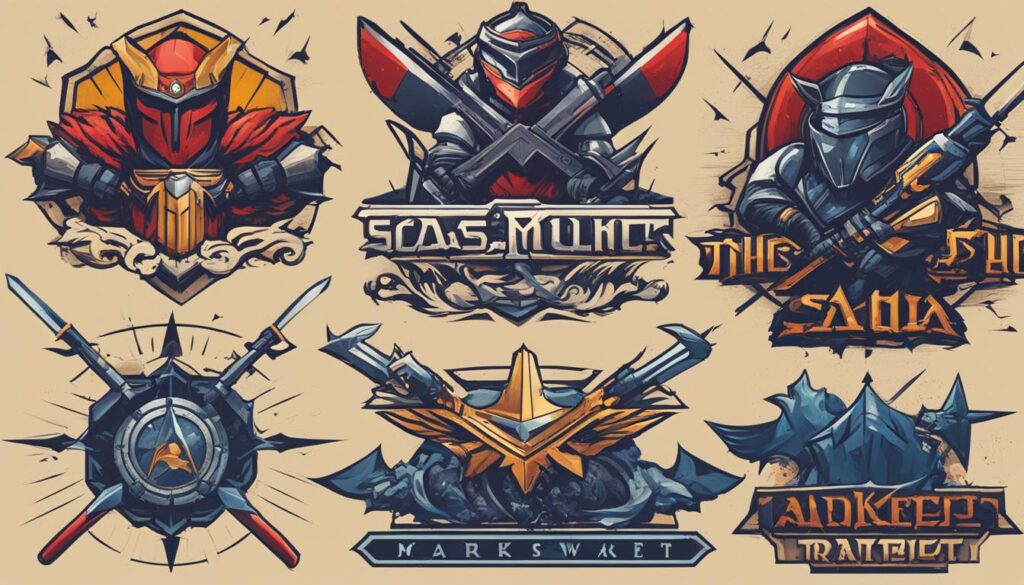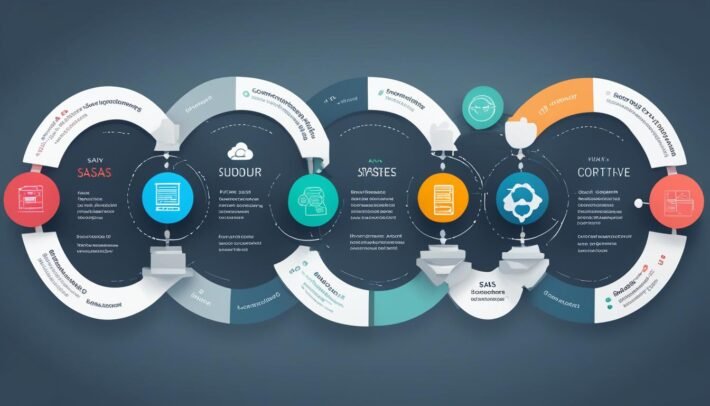Analyzing the Competitive Landscape in the SAAS Market

As the software-as-a-service (SAAS) market continues to grow, businesses must stay ahead of the competition to remain successful. Conducting competitive analysis and market research is critical to achieving this. By analyzing the SAAS competition, businesses can identify key market trends, competitor strategies, customer preferences, and more. In this section, we will discuss the significance of competitive analysis in the SAAS market and its role in driving business success.
Key Takeaways:
- Competitive analysis is crucial for businesses operating in the SAAS market.
- Analyzing the competition can provide valuable insights into market trends and competitor strategies.
- Meticulously mapping out the competitive landscape can help businesses remain competitive.
- Understanding pricing, customer satisfaction, and product development can give businesses a competitive edge.
- Continuous competitive analysis can help businesses stay updated on market trends and competitor activities.
Understanding the Significance of Competitive Analysis
Competitive analysis is an essential part of the SAAS industry, providing valuable insights into market trends, competitor strategies, and customer preferences. By conducting comprehensive market research, businesses can better understand their target audience and stay ahead of competitors.
Competitive analysis helps businesses make informed decisions and formulate effective strategies for success. It helps identify gaps in the market and reveals potential areas for growth and expansion. Moreover, it enables businesses to keep an eye on the competition and capitalize on their strengths while mitigating challenges and threats.
Conducting competitive analysis empowers businesses to better meet the needs and expectations of their customers, making their products and services more relevant and valuable to the market. Additionally, it enhances customer satisfaction and loyalty by identifying areas for improvement and optimization.
Market research and competitive analysis involve gathering data and insights from a variety of sources, including surveys, social media, user feedback, and competitor analysis tools. By analyzing this information, businesses can make informed decisions and stay nimble in an ever-changing market landscape.
Identifying Key Market Trends
Competitive analysis is incomplete without analyzing key market trends. By identifying these trends, businesses can gain insights into market demand and adapt to better serve their target audience. Market research can help organizations to understand customer needs, trends, and preferences. Understanding key market trends can help businesses in making strategic decisions and foreseeing challenges and opportunities.
Emerging Trends in SAAS Industry
One of the emerging trends in the SAAS industry is the increasing adoption of artificial intelligence and machine learning in software products. This trend is driven by the need to create more intelligent and efficient software that can streamline processes, reduce costs, and deliver better user experiences. Another trend is the growing demand for cloud-based solutions, enabling customers to access software products anytime, anywhere, and on any device. Moreover, the SAAS market is witnessing the penetration of small and medium-sized enterprises. These businesses are adopting SAAS solutions to streamline their operations and reduce costs.

Comparative Analysis of Market Trends
| Trend | Impact on SAAS Market | Examples of Companies Adopting the Trend |
|---|---|---|
| Artificial Intelligence and Machine Learning | Increasing efficiency of software products and delivering better user experience | IBM, Microsoft, Salesforce |
| Cloud-based Solutions | Enhancing accessibility and flexibility for customers | Adobe, Dropbox, Google |
| Penetration of Small and Medium-sized Enterprises | Creating new market opportunities and revenue streams for SAAS providers | Freshworks, Slack, Zoho |
The comparative analysis of key market trends showcases the impact of trends on the SAAS market and highlights the industry players adopting them. Such analysis helps businesses to identify areas of growth and expansion while keeping in mind customers’ preferences and market demand.
Mapping out the Competitive Landscape
Conducting a comprehensive competitive analysis is key for businesses looking to succeed in the SAAS market. Mapping out the competitive landscape involves identifying and analyzing competitors’ strengths, weaknesses, and unique selling propositions. This information can help businesses develop effective strategies to differentiate themselves from their competitors and gain market share.
Market research is crucial in mapping out the competitive landscape. There are various methodologies and tools available to gather insights about competitors, including:
- Industry reports
- Competitor websites and social media channels
- Customer reviews and feedback
- Interviews with industry experts
An effective way to visualize the competitive landscape is through a competitive matrix. A competitive matrix is a table that compares a business’s products or services with those of its competitors. By using a competitive matrix, businesses can identify gaps in the market and opportunities for differentiation.
Another useful tool in mapping out the competitive landscape is a SWOT analysis. A SWOT analysis helps businesses identify their strengths, weaknesses, opportunities, and threats, as well as those of their competitors. This analysis can help businesses develop effective strategies based on their unique positioning in the market.
Overall, mapping out the competitive landscape through market research and various tools and methodologies can provide a deeper understanding of the SAAS competition. This information can help businesses develop effective strategies to differentiate themselves, gain market share, and ultimately drive success.
Conducting Competitor Profiling
Competitive analysis involves researching and analyzing data about competitors to gain information on their strengths, weaknesses, and unique selling propositions. Conducting competitor profiling is an essential part of this process, as it helps businesses gain insights into their competitors’ strategies and market positioning.
The first step in conducting competitor profiling is to identify key competitors in the SAAS market. Once identified, businesses should research and analyze competitors’ online presence, including their website, social media pages, and online reviews. Analyzing competitors’ marketing tactics and messaging can also provide valuable insights into their positioning and target audience.

Next, businesses should analyze competitors’ products and services to identify unique features, pricing strategies, and target markets. This research can be conducted through product demos, free trials, or third-party reviews. Competitor pricing and packaging strategies should also be analyzed to gain insights into their market positioning.
Finally, businesses should assess competitors’ strengths and weaknesses, as well as their unique selling propositions. This can be achieved through SWOT analysis or competitor comparisons using a matrix or table. The insights gained from competitor profiling should be used to inform businesses’ competitive strategies, helping them to position themselves within the SAAS market and differentiate from competitors.
Analyzing Competitor Strategies
In order to gain a competitive edge in the SAAS market, it is essential to understand the strategies employed by competitors. Through a competitive analysis, businesses can gather valuable insights into pricing strategies, marketing tactics, and product differentiation techniques.
Pricing Strategies
Pricing is a critical aspect of SAAS competition and can heavily impact a business’s market positioning. Competitors may adopt different pricing models, such as flat-rate, usage-based, or freemium. Additionally, they may offer different pricing packages, such as enterprise or individual options. A thorough analysis of pricing strategies can aid businesses in determining the optimal pricing structure for their products and services.
Marketing Tactics
Competitors may employ various marketing tactics to attract and retain customers. These tactics can include SEO optimization, content marketing, email campaigns, and social media marketing. By analyzing competitor marketing strategies, businesses can identify areas for improvement in their own marketing efforts.
Product Differentiation Techniques
In a crowded SAAS market, it is essential to differentiate products from those of competitors. Competitor analysis can aid in identifying unique features, functionalities, and benefits that distinguish a product or service. By analyzing differentiating factors, businesses can position themselves more advantageously and potentially attract more customers.
“Without a strategy, marketing is just throwing spaghetti against the wall and hoping something sticks.” – Anonymous
Analyzing competitor strategies through a comprehensive market research and competitive analysis can provide valuable insights for formulating a successful competitive strategy.
Evaluating Market Share and Positioning
Competitive analysis involves gathering and analyzing data on market share and positioning to gain insight into how businesses stack up against their competitors. By evaluating these metrics, companies can gain an understanding of their strengths and weaknesses, as well as those of their rivals. This information can then be used to make strategic decisions and identify areas for growth and improvement.
Evaluating Market Share
Market share is a vital metric for businesses to monitor as it shows how their brand is performing against competitors within their industry. This information can be gathered through market research, which involves surveying customers and analyzing sales data. Market share can also be observed through social media and online discussions.
One effective way to evaluate market share is by comparing revenue and sales figures with those of the competitors. This can be done with the use of tables and graphs, as shown below:
Evaluating Positioning
Positioning refers to how a brand is perceived by consumers. It considers factors such as its reputation, pricing, and product features. Understanding your competitors’ positioning can help businesses identify gaps in the market and areas where they can differentiate themselves.
One approach to evaluating positioning is by using a perceptual map, which compares different brands based on key attributes. This can help businesses identify where they stand in relation to their competitors and where they can improve their position to gain a competitive advantage.
“By evaluating market share and positioning, businesses can gain a clear understanding of where they stand in the market and how they can improve their competitive edge.”
Uncovering Customer Insights
Competitive analysis is not just about keeping track of competitors; it is also about understanding customers. By conducting market research, businesses can gather valuable insights into what their customers want and need. This information can help them create products and services tailored to customer preferences and optimize the customer experience.
Surveys are a common method for collecting customer feedback. Businesses can ask customers about their experience using their product or service, as well as their satisfaction levels. Interviews with customers can also provide in-depth insights into their needs, preferences, and pain points. User feedback analysis can be obtained through social media platforms, online forums, and product review websites. By analyzing customer feedback, businesses can identify areas for improvement and develop strategies to differentiate themselves from competitors.
Moreover, by understanding customer behavior and preferences, businesses can uncover market gaps and identify unmet customer needs. This information can be used to create innovative solutions that attract new customers and retain existing ones. Image_8.1: Using customer feedback to improve products and services

Assessing Competitive Threats and Opportunities
Identifying potential threats and opportunities is crucial for businesses operating in the SAAS market. Conducting comprehensive competitive analysis allows companies to stay ahead of competitors and adapt their strategies to changing market conditions.
One way to assess potential threats and opportunities is by conducting a SWOT analysis. This involves identifying an organization’s strengths, weaknesses, opportunities, and threats. By identifying areas of weakness, businesses can implement measures to improve their offerings, while areas of strength can be leveraged to gain a competitive advantage.
Another way to assess competitive threats and opportunities is by using market research. By analyzing market trends and customer behavior, businesses can identify areas for growth and expansion. For example, if a particular segment of the SAAS market is seeing strong growth, a company may consider investing in that segment to capitalize on the trend.
It is essential to continuously monitor the competitive landscape to identify new threats and opportunities. This can be achieved by implementing a continuous competitive analysis approach. By regularly assessing the market and competitor activities, businesses can stay informed and adapt their strategies to remain successful.
Analyzing Pricing and Packaging Strategies
In the competitive SAAS market, pricing and packaging strategies can make or break a business. Therefore, conducting a thorough analysis of these strategies is crucial in developing a successful business plan.
Through market research and competitive analysis, businesses can gain valuable insights into what pricing models and packages work best for their target audience. By understanding their competitors’ pricing and packaging strategies, businesses can adjust their own strategies to remain competitive and appeal to customers.
There are various pricing models to consider, such as value-based pricing, subscription-based pricing, and usage-based pricing, among others. Each model has its own advantages and disadvantages that can impact a business’s market positioning and profitability.
Additionally, packaging strategies, such as bundling and tiered pricing, can influence customer purchasing decisions and retention. Analyzing and comparing these strategies can reveal opportunities for differentiation and improvement within a business’s pricing and packaging approach.
Overall, analyzing pricing and packaging strategies through competitive analysis and market research can inform strategic decisions and positioning within the SAAS market.
Evaluating Customer Satisfaction and Support
Customer satisfaction and support are critical components of a successful SAAS business. Conducting competitive analysis can help identify the strengths and weaknesses of competitors’ customer support services, providing insights into areas where your business can improve.
One way to gather feedback is through customer surveys. These surveys can provide valuable information about customer satisfaction levels, as well as identify areas for improvement. Analyzing customer support tickets and reviews can also shed light on common complaints or pain points.
It’s important to also analyze competitors’ support offerings, such as the channels they use to provide support (e.g. email, phone, chat), the responsiveness of their support team, and the quality of their support documentation.
Tracking Innovation and Product Development
Tracking innovation and product development is crucial for businesses looking to stay ahead in the competitive SAAS market. By consistently improving and offering new features and functionalities, companies can attract and retain customers, gain new market share, and ultimately drive growth. Here, we will explore how market research and competitive analysis can aid in tracking innovation and product development.
Market Research
Conducting market research is important for any business looking to track innovation and product development in the SAAS market. By gathering insights into customer needs, preferences, and pain points, companies can tailor their product development efforts to meet these demands. In addition, market research can provide valuable information about emerging trends and technologies that can be leveraged to gain a competitive advantage.
Example: A recent study found that 60% of SAAS users prefer cloud-based solutions over on-premise software due to the flexibility and scalability they offer. This insight can inform businesses on the importance of offering cloud-based solutions in their product development efforts.
Competitive Analysis
Competitive analysis is another key tool for tracking innovation and product development in the SAAS market. By analyzing the features and functionalities offered by competitors, businesses can identify gaps in the market and opportunities for differentiation. In addition, tracking the product development efforts of competitors can provide insight into emerging trends and innovative technologies being utilized.
Example: By analyzing the pricing and packaging strategies of competitors, a SAAS company may identify an opportunity to offer a more affordable entry-level package with limited features to appeal to budget-conscious customers.
Continuous Improvement
Finally, businesses must adopt a mindset of continuous improvement to effectively track innovation and product development in the SAAS market. This means constantly gathering feedback from customers and analyzing market trends and competitor activities to inform product development efforts. By keeping a pulse on the market and consistently iterating on products, businesses can remain competitive and drive growth.
Formulating Competitive Strategies for Success
Competitive analysis and market research can help businesses identify their unique strengths and weaknesses. These insights can guide businesses to develop strategies for success, including leveraging their strengths and exploiting their competitors’ weaknesses.
An effective competitive strategy considers market trends, customer needs, and competitor behavior. By analyzing this information, businesses can create an action plan to improve their market positioning and outperform their competitors.
One common competitive strategy is differentiation. This involves positioning a business as unique by offering a product or service that stands out from the competition. To achieve differentiation, businesses must identify and enhance their unique value propositions, such as superior customer service or innovative features.
Pricing strategies are also a crucial aspect of competitive strategy. Depending on their target market and competition, businesses may choose to compete on price, or they might charge a premium for higher-quality products or services. By analyzing competitor pricing strategies and market trends, businesses can determine the best pricing model for their products.
Overall, competitive analysis and market research provide the foundation for developing successful competitive strategies. By understanding the competitive landscape, businesses can make informed decisions to stay ahead of the competition and achieve long-term success.
Implementing a Continuous Competitive Analysis Approach
Staying ahead of the competition is a constant process, rather than a one-time activity. Companies must implement a continuous competitive analysis approach to stay updated on market trends and competitor activities.
One strategy is to set up alerts for industry keywords, competitor names, and relevant news using tools such as Google Alerts, Mention, or Social Mention. Another approach is to monitor social media channels and online forums to gather customer feedback and insights on competitor products.
“Continuous improvement is better than delayed perfection.” – Mark Twain
By regularly reviewing and analyzing competitor strategies, businesses can adapt and refine their own approaches to achieve success in the SAAS market.
The Benefits of Continuous Competitive Analysis
| Benefits | Explanation |
|---|---|
| Better market positioning | Regular analysis and adaptation of business strategies to market trends and customer preferences. |
| Improved competitiveness | Identification and mitigation of potential risks and threats from competitors, as well as leveraging their weaknesses and opportunities for growth. |
| Increased innovation | Tracking and analyzing competitor product development and innovation to stay ahead of the curve in terms of features and functionalities. |
| Enhanced customer satisfaction | Understanding and meeting customer needs and preferences by gathering insights from competitor feedback and experiences. |
Overall, implementing a continuous competitive analysis approach can lead to improved market positioning, competitiveness, innovation, and customer satisfaction. It’s a vital process for companies operating in the SAAS market to not only stay afloat but to thrive.
Conclusion
Competitive analysis is an essential component of success in the SAAS market. Market research provides valuable insights into competitor strategies, market trends, and customer preferences, which can help businesses adapt their strategies to remain competitive.
By identifying key market trends, mapping out the competitive landscape, conducting competitor profiling, analyzing competitor strategies, evaluating market share and positioning, uncovering customer insights, assessing competitive threats and opportunities, analyzing pricing and packaging strategies, evaluating customer satisfaction and support, tracking innovation and product development, formulating competitive strategies for success, and implementing a continuous competitive analysis approach, businesses can stay ahead in the SAAS competition.
Through the conduct of regular market research, businesses can gather data and insights to develop strategies that help to leverage their strengths and exploit competitors’ weaknesses, ensuring success in the ever-changing SAAS market.
Stay ahead of the competition with regular competitive analysis!
FAQ
What is competitive analysis?
Competitive analysis is the process of researching and evaluating your competitors to gain insights into their strategies, market positioning, and customer base. It helps businesses understand their competitive landscape and make informed decisions to stay ahead in the SAAS market.
Why is competitive analysis important in the SAAS market?
Competitive analysis is crucial in the SAAS market as it provides valuable insights into market trends, competitor strategies, and customer preferences. By understanding the competitive landscape, businesses can identify opportunities, optimize their offerings, and differentiate themselves from competitors.
How can businesses identify key market trends?
To identify key market trends, businesses can analyze industry reports, market research data, and customer feedback. Additionally, monitoring competitor activities, attending industry events, and staying updated on technological advancements can help identify emerging trends within the SAAS market.
What are some methodologies and tools for mapping out the competitive landscape?
There are various methodologies and tools available to map out the competitive landscape. These include SWOT analysis, Porter’s Five Forces framework, market share analysis, and competitor benchmarking. Additionally, tools like SEMrush, SimilarWeb, and Google Keyword Planner can aid in gathering data and insights about competitors.
How can businesses conduct competitor profiling?
To conduct competitor profiling, businesses can start by identifying key competitors and collecting information on their products, pricing, target audience, marketing strategies, and customer feedback. This can be done through online research, analyzing public statements and reports, and monitoring social media channels and review websites.
What should businesses analyze when studying competitor strategies?
When analyzing competitor strategies, businesses should focus on pricing strategies, marketing tactics, product differentiation techniques, customer acquisition and retention strategies, and overall messaging and brand positioning. By understanding these strategies, businesses can identify areas where they can differentiate themselves and gain a competitive advantage.
How can businesses evaluate market share and positioning?
To evaluate market share and positioning, businesses can analyze market data, industry reports, and competitor financial statements. They can also conduct customer surveys, monitor social media discussions, and gather insights on customer perception and preferences.
How can competitive analysis uncover valuable customer insights?
Competitive analysis can uncover valuable customer insights by examining competitor’s customer reviews, feedback, and complaints. It can also involve conducting surveys and interviews with customers to understand their needs, pain points, and preferences. Analyzing user feedback and studying customer journeys can provide valuable insights into improving the overall customer experience.
How can businesses assess competitive threats and opportunities?
Businesses can assess competitive threats and opportunities by analyzing market trends, competitor strategies, and customer demands. They should identify potential disruptors, technological advancements that may impact the market, and emerging opportunities for growth and expansion.
What should businesses consider when analyzing pricing and packaging strategies?
When analyzing pricing and packaging strategies, businesses should consider competitor pricing models, the value proposition offered, pricing elasticity, and overall market demand. They should also evaluate the impact of different pricing strategies on customer acquisition, retention, and revenue generation.
Why is evaluating customer satisfaction and support important in SAAS?
Evaluating customer satisfaction and support is crucial in the SAAS market as it directly impacts customer retention and long-term business success. By collecting feedback, analyzing customer support interactions, and monitoring customer sentiment, businesses can identify areas for improvement and deliver exceptional customer experiences.
How can businesses track innovation and product development in the SAAS market?
To track innovation and product development, businesses should monitor competitor product releases, updates, and feature enhancements. They should also analyze customer feedback, attend industry events and conferences, and keep an eye on technological advancements that may influence the market.
How can businesses formulate competitive strategies based on analysis?
To formulate competitive strategies, businesses should leverage the insights gathered from their analysis. They can identify their strengths and unique selling propositions and develop strategies that exploit their competitors’ weaknesses. By understanding customer preferences and market trends, businesses can create innovative offerings and effectively position themselves in the market.
Why is implementing a continuous competitive analysis approach important?
Implementing a continuous competitive analysis approach is important as the SAAS market is dynamic and ever-changing. By staying updated on market trends, competitor activities, and customer preferences, businesses can adapt their strategies, identify new opportunities, and proactively address competitive challenges.
What is the key takeaway from this article on competitive analysis in the SAAS market?
The key takeaway from this article is that competitive analysis plays a vital role in driving success for businesses in the SAAS market. By understanding the competitive landscape, businesses can make informed decisions, differentiate themselves, and capitalize on market trends and customer preferences.



